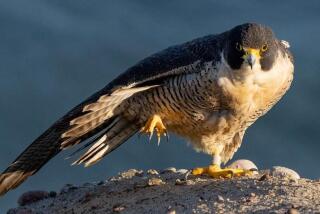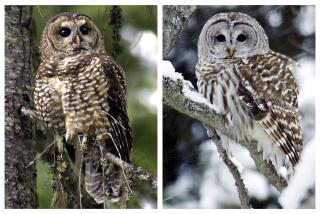Save the birds
- Share via
If you live in a large American city, you can probably drive a short distance to a skyscraper or bridge, spot a peregrine falcon nesting high above the ground and, if you stick around long enough, watch it dive down in pursuit of a pigeon at a speed of up to 200 miles per hour, capture the bird with its feet, kill it with a swift bite to the neck and devour the carcass in a nearby tree.
The peregrine falcon is marvelously abundant throughout the country and the world today, but that wasn’t true 40 years ago. During the 1950s and ‘60s, the pesticide DDT dramatically reduced the peregrine’s reproductive success by causing it to lay eggs with abnormally thin shells. The bird might have gone extinct if not for the growth of the environmental movement in the late 1960s and early 1970s, which led to the banning of DDT, the passage of the Endangered Species Act and the allocation of public money for captive breeding programs and other conservation projects.
Last month, the U.S. Fish and Wildlife Service, in conjunction with several conservation organizations, released a State of the Birds report, an assessment of the health of the country’s 800 bird species. The findings were mixed. On the one hand, nearly one-third of our birds face the possibility of extinction, have suffered a serious population decline or are in danger of such a decline. On the other hand, many of the species that were in trouble several decades ago, such as the peregrine falcon and dozens of wetland birds, are now thriving precisely because our conservation efforts have paid off.
“People focus on the fact that indeed a large number of birds are declining, but what we have learned in the past 20 or 30 years is that, if we actually read the data and adjust our behavior and do some conservation, they can rebound,” said John Fitzpatrick, director of the Cornell Laboratory of Ornithology and one of the contributors to the report.
The banning of DDT and other toxic pesticides also has led to the recovery of the bald eagle and the brown pelican in recent decades, according to the report. Over the same period, Duck Stamps, which give hunters and bird watchers a year’s access to National Wildlife Refuges for $15, have generated hundreds of millions of dollars in revenue, nearly all of which has gone to expanding wetland refuges. As a result, wetland bird populations have increased by nearly 60% since 1968, the report found. Species that have made particularly impressive recoveries include the American white pelican, osprey and double-crested cormorant.
Many of the birds we risk losing now are in Hawaii, which is home to about 30 of the roughly 75 American bird species and subspecies protected under the Endangered Species Act but receives only about 4% of the public money spent on threatened birds. Although 10 of these Hawaiian birds haven’t been seen in decades and could be extinct, many of the others are eminently savable, according to George Wallace, vice president of the American Bird Conservancy and another contributor to the State of the Birds report.
“Hawaii has tended to be out of sight and out of mind,” Wallace said. “We need to aggressively take steps to change that.”
Until that happens, birds such as the Maui parrotbill will remain imperiled. A small yellow honeycreeper with a curved, parrot-like beak, the Maui parrotbill has been reduced to a single population of about 500 birds in a stormy, high-elevation rain forest. Feral pigs, an introduced species, have degraded the bird’s habitat, eating holes in the trunks of tree ferns that then fill with water and become breeding grounds for mosquitoes, another introduced species. The mosquitoes, in turn, infect parrotbills and other birds with malaria. Because Hawaiian birds didn’t evolve with mosquitoes -- Europeans brought the insect to the islands in the 1800s -- they have no resistance to the disease.
Currently, only about $100,000 a year of public money is spent on parrotbill conservation. If we spent between $250,000 and $400,000 a year over 10 years, Wallace said, the entire range of the surviving population could be fenced off to keep pigs and other introduced ungulates out, and a few of the birds could be translocated to a part of Maui with less severe weather in hopes of establishing a second, more fecund population. With these measures in place, the population of the species could be doubled in 10 to 20 years, Wallace said, significantly increasing its chances of long-term survival.
On the mainland, the birds that most need our attention are desert species, which together have suffered a 30% decline in population since 1968, and grassland species, whose populations are down 35%, according to the report. To reverse these declines, we need to put more money into habitat preservation and restoration.
The plights of both desert and grassland birds would be significantly improved, Fitzpatrick said, if the federal government were to increase its annual appropriation to acquire new land for the National Wildlife Refuge system. In recent years, this appropriation, under the Land and Water Conservation Fund Act, has been between $100 million and $200 million; conservationists would like to see that figure rise to $800 million. For that sum, the refuges could expand to include a significant amount of grassland, desert and forest habitat, giving terrestrial birds the same opportunity to rebound that wetland birds have been afforded through the Duck Stamp program.
The birds can be saved. The only question is, do we care enough to save them?
Some environmentalists talk about saving species because we have a moral imperative to do so. Others emphasize that we never know when a plant or animal will prove useful to medicine. Still others make the point that for the sake of our own health -- physical and economic -- we need to preserve and protect the nation’s natural resources.
I agree with all of these arguments. But to me, the most compelling case for saving the birds is simply beholding a peregrine falcon and taking a moment to consider that we almost destroyed it.
More to Read
Sign up for The Wild
We’ll help you find the best places to hike, bike and run, as well as the perfect silent spots for meditation and yoga.
You may occasionally receive promotional content from the Los Angeles Times.






